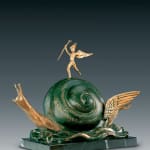Salvador Dali Spanish, 1904-1989
Snail and the Angel, 1984
Bronze lost wax process
17.3" x 13.7" x 23.6"
350+35EA
Copyright The Artist
Further images
Patina: Green/Gold The snail occupies an important place in the Dalinian universe, as it is intimately connected with Sigmund Freud, whom Dalí came to regard as his spiritual father. Dalí...
Patina: Green/Gold
The snail occupies an important place in the Dalinian universe, as it is intimately connected with Sigmund Freud, whom Dalí came to regard as his spiritual father. Dalí was surrounded by psychoanalytical influences and theories of the subconscious were incorporated into his art. Dalí longed to meet Freud and once sketched his head with the likeness of a snail, in the form of a spiral symbolizing “a morphological secret”.
When he finally met his idol, he was struck by a specific scene near Freud’s house; on the saddle of a bicycle was a red hot water bottle on which crawled a snail!
Dalí was obsessed with snails, they were a fetish of his and a source of inspiration for his artistic oeuvre. Apart from being one of his favorite foods, he was fascinated by the natural geometry of their shells and the idea of duality: hard exterior and soft interior, just like the egg and the lobster.
Dalí adds a surrealist touch to the sculpture; paradoxically, the snail, universal symbol of the idle passing of time, has been granted wings, and is seen here riding rapidly on waves.
An angel lands softly on its back, bestowing the gift of swift movement. This messenger acts as an intermediary between real and imaginary worlds and holds triumphantly a crutch, another important Dalinian symbol.
The snail’s languid pace contrasts with the angel’s speedy flight; a sharp distinction is also drawn between the ponderous movement of the snail and the agile gracefulness of the angel.
R. & N. Descharnes Salvador Dali Sculptures & Objects. Eccart. Ref. 621, page 241.
The snail occupies an important place in the Dalinian universe, as it is intimately connected with Sigmund Freud, whom Dalí came to regard as his spiritual father. Dalí was surrounded by psychoanalytical influences and theories of the subconscious were incorporated into his art. Dalí longed to meet Freud and once sketched his head with the likeness of a snail, in the form of a spiral symbolizing “a morphological secret”.
When he finally met his idol, he was struck by a specific scene near Freud’s house; on the saddle of a bicycle was a red hot water bottle on which crawled a snail!
Dalí was obsessed with snails, they were a fetish of his and a source of inspiration for his artistic oeuvre. Apart from being one of his favorite foods, he was fascinated by the natural geometry of their shells and the idea of duality: hard exterior and soft interior, just like the egg and the lobster.
Dalí adds a surrealist touch to the sculpture; paradoxically, the snail, universal symbol of the idle passing of time, has been granted wings, and is seen here riding rapidly on waves.
An angel lands softly on its back, bestowing the gift of swift movement. This messenger acts as an intermediary between real and imaginary worlds and holds triumphantly a crutch, another important Dalinian symbol.
The snail’s languid pace contrasts with the angel’s speedy flight; a sharp distinction is also drawn between the ponderous movement of the snail and the agile gracefulness of the angel.
R. & N. Descharnes Salvador Dali Sculptures & Objects. Eccart. Ref. 621, page 241.


